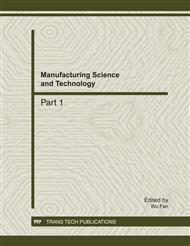[1]
Roberts, S.W. Control Chart Tests Based on Geometric Moving Averages [J]. Technometrics, 1959, 1: 39~250.
DOI: 10.1080/00401706.1959.10489860
Google Scholar
[2]
Crowder, S.V. A simple Method for Studying Run Length Distributions of Exponentially.
Google Scholar
[1]
Weighted Moving Chart [J]. Technometrics, 1987, 29: 93~407.
Google Scholar
[3]
Crowder, S.V. Design of Exponentially Weighted Moving Average Schemes [J]. Journal of.
Google Scholar
[1]
Quality Technology, 1989, 21: 55-162.
Google Scholar
[4]
Lucas, J.M. and Saccucci, M.S. Exponentially Weighted Moving Average Control Schemes.
Google Scholar
[1]
Properties and Enhancements [J]. Technometrics, 1990, 32(1): ~12.
Google Scholar
[5]
J. Bert Keats, John D. Miskulin, Runger, G.C. Statistical Process Control Scheme Design [J].
Google Scholar
[1]
Journal of Quality Technology, 1995, 27(1): 31~246.
Google Scholar
[6]
Calzada, M.E., Scariano, S.M. Reconciling the Integral Equation and Markov Chain.
Google Scholar
[1]
Approaches for Computing EWMA Average Run Lengths [J]. Communications in Statistics.
Google Scholar
[1]
2003, 32(2): 91~604.
Google Scholar
[7]
S. W. Roberts, Control chart tests based on geometric moving averages, Technometrics, 1959, 1, 239-250.
DOI: 10.1080/00401706.1959.10489860
Google Scholar
[8]
S. W. Roberts, A comparison of some control chart procedures, Technometrics, 1966, 8, 411-430.
DOI: 10.1080/00401706.1966.10490374
Google Scholar
[9]
P. B. Robison, T. Y. Ho. Average run lengths of geometric moving average charts by numerical methods, Technometrics, 1978, 20, 85-93.
DOI: 10.1080/00401706.1978.10489620
Google Scholar
[10]
D. Brook, D. A. Evans, An approach to the probability distribution of CUSUM run length, Biometrics, 1972, 59, 539-549.
DOI: 10.1093/biomet/59.3.539
Google Scholar
[11]
J. F. Macgregor, T. J. Harris, Discussion of Exponentially weighted moving average control schemes: properties and enhancements, Technometics, 1990, 32(1), 23-26.
DOI: 10.2307/1269840
Google Scholar
[12]
G. Capizzi, G. Masarotto, An adaptive exponentially weighted moving average control chart, Technometics, 2003, 45, 199-207.
DOI: 10.1198/004017003000000023
Google Scholar
[13]
Z. G. Stoumbos, M. R. Reynolds, Robustness to non-normality and autocorrelation of individuals control charts, Journal of statistical computing simulation, 2000, 66, 145-187.
DOI: 10.1080/00949650008812019
Google Scholar


